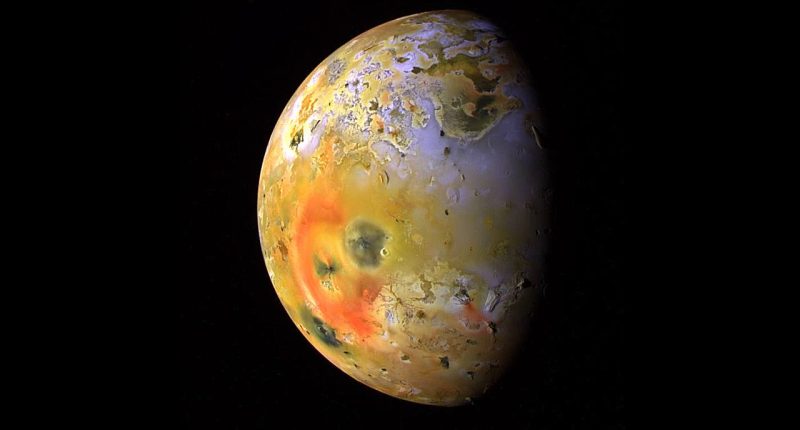IO – Jupiter’s third largest moon – might appear like a volcanic hellscape, but it could be a destination spot for future thrill-seeking space tourists.
The lonely moon, a quarter the size of Earth, is covered with roughly 400 active volcanoes and more than 135 mountains.
In a future where there’s extraterrestrial human colonies and heatproof spacesuits, tours to Io may become popular.
Scientists have only seen the volcanic planet from afar.
But new animations from Nasa’s Jet Propulsion Lab (JPL), based on data collected by its Juno spacecraft in December and February of this year, show what Io looks like up close.
The specular reflection our instruments recorded of the lake suggests parts of Io’s surface are as smooth as glass, reminiscent of volcanically created obsidian glass on Earth.
Scott Bolton, Juno’s principal investigator at Nasa
Loki Patera
Io is home to many lava lakes, but one of particular interest to Nasa – and therefore, tourists – is Loki Patera.
READ MORE ON SPACE
“Io is simply littered with volcanoes, and we caught a few of them in action,” Juno’s principal investigator Scott Bolton told a news conference in mid-April, when the animations were released.
“We also got some great close-ups and other data on a 200-kilometer-long (127-mile-long) lava lake called Loki Patera.”
This active lava lake has caught the eyes of scientists for a rather unique reason: its extremely reflective surface.
Unlike lakes on Earth, Loki Patera’s glimmer is due to entirely different properties.
Most read in Science
“There is amazing detail showing these crazy islands embedded in the middle of a potentially magma lake rimmed with hot lava,” Bolton explained.
“The specular reflection our instruments recorded of the lake suggests parts of Io’s surface are as smooth as glass, reminiscent of volcanically created obsidian glass on Earth.”
Steeple Mountain
This highly unusual mountain is sure to draw in space tourists.
Nicknamed “Steeple Mountain” by the Juno science team, the landmark is between 3 and 4.3 miles (5 and 7 kilometers) high.
One side of Steeple Mountain is in shade in the animation because only one side of the mountain was illuminated when imaged by JunoCam.
But walking through its towering shadow would feel like night and day on the ground.
Mount Boösaule
Mount Boösaule is Io’s longest and tallest mountain – and dwarfs every mountain range on Earth.
It is 350 miles (570 km) long, and an incredible 17,500 metres (57,400 ft) tall.
That’s about double the size of Everest, the tallest mountain on Earth, which is some 8,849metres tall.
It’s sheer size makes Boösaule hard to miss.
But future space tourists could travel from far and wide to climb it, just like its Nepalese inferior.
Because Io is much smaller than Earth, it has a lot less gravity pulling you down.
So, interstellar travellers may find it easier to climb – and summit – than any mountain on Earth.
Mysterious dunes
Unlike every other moon, Io has no impact craters to observe – unlike Mars.
This is because Io’s many volcanic eruptions tend to wipe away any impact craters.
What Io has lots of, however, is mysterious “grand” sand dunes – despite a lack of wind blowing them into formation.
“Our studies point to the possibility of Io as a new ‘dune world,’” George McDonald, a postdoctoral researcher in Rutgers’ Earth and Planetary Sciences Department, wrote in a 2022 study.
“We have proposed, and quantitatively tested, a mechanism by which sand grains can move, and in turn dunes could be forming there.”
These rolling sand banks are thought to be “considerably more varied than the classical, endless desert landscapes on parts of Earth or on the fictional planet Arrakis in ‘Dune,’” according to McDonald.
But their very existence had puzzled scientists for years.
READ MORE SUN STORIES
Classical wind-blown dunes like those found on Earth weren’t originally thought to be possible on Io, due to its low-density atmosphere.
Scientists now reckon that the chemical reaction produced when lava flows into sulfur dioxide beneath the moon’s surface is “dense and fast moving enough to move grains on Io and possibly enable the formation of large-scale features like dunes,” McDonald said.
Find out more about science
Want to know more about the weird and wonderful world of science? From the Moon to the human body, we have you covered…















